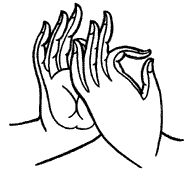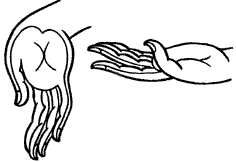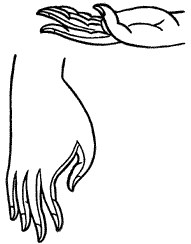Mudras are a non-verbal mode of communication and self-expression, consisting of hand gestures and finger-postures. They are symbolic sign based finger patterns taking the place, but retaining the efficacy of the spoken word, and are used to evoke in the mind ideas symbolizing divine powers or the deities themselves. The composition of a mudra is based on certain movements of the fingers; in other words, they constitute a highly stylized form of gestureal communication. It is an external expression of 'inner resolve', suggesting that such non-verbal communications are more powerful than the spoken word.
Many such hand positions were used in the Buddhist sculpture and painting of India, Tibet, China, Korea and Japan. They indicate to the faithful in a simple way the nature and the function of the deities represented. Mudras are thus gestures which symbolize divine manifestation. They are also used by monks in their spiritual exercises of ritual meditation and concentration, and are believed to generate forces that invoke the deity.
But a mudra is used not only to illustrate and emphasize the meaning of an esoteric ritual. It also gives significance to a sculptural image, a dance movement, or a meditative pose, intensifying their potency. In its highest form, it is a magical art of symbolical gestures through which the invisible forces may operate on the earthly sphere. It is believed that the sequence itself of such ritual hand postures may have eventually contributed to the development of the mudras of Indian Classical dance.
Another interesting meaning is given to the idea of the mudra. It reveals the secret imbibed in the five fingers. In such an interpretation, each of the fingers, starting with the thumb, is identified with one of the five elements, namely the sky, wind, fire, water, and the earth. Their contact with each other symbolizes the synthesis of these elements, significant because every form in this universe is said to be composed of a unique combination of these elements. This contact between the various elements creates conditions favorable for the presence of the deity at rites performed for securing some desired object or benefit. That is, mudras induce the deity to be near the worshipper.
While there are a large number of esoteric mudras, over time Buddhist art has retained only five of them for the representations of the Buddha. Images of the Buddha which exhibit mudras other than these are extremely rare. The significance of these mudras can be gauged from the fact that each of the five transcendental (Dhyani) Buddhas is assigned one of these mudras, and they are invariably depicted in visual arts with this particular mudra only.
These five mudras are:

|
Gesture of Turning the Wheel of Dharma The thumb and index finger of the right hand stand for wisdom and method combined. The other three raised fingers symbolize the teaching of the Buddhist doctrine, which leads sentient beings to the paths of the beings of three capacities. The position of the left hand symbolizes the beings of the three capacities, who follow the combined path of method and wisdom. |

|
Gesture of Meditation The nerve channel associated with the mind of enlightenment (Bodhichitta) passes through the thumbs. Thus, joining of the two thumbs in this gesture is of auspicious significance for the future development of the mind of enlightenment. |

|
Gesture of Bestowal of Supreme Accomplishment The gesture of the right hand symbolizes bestowal of supreme accomplishment. That of the left hand symbolizes meditation. Together, they stand for the Buddha's power to bestow supreme and general accomplishments on his disciples, while he meditates. |

|
Gesture of Pressing the Earth The right hand gestures pressing the earth to bear witness. The position of the left hand symbolizes meditation. Together, they stand for the Buddha's overcoming of hindrances while meditating. This gesture 'of touching the earth' or 'calling the earth to witness', commemorates Gautama Buddha's victory over temptation by the demon Mara. |

|
Gesture of Turning the Wheel of Dharma while in Meditation The gesture of the right hand stands for turning the wheel of Dharma, while that of the left hand symbolizes meditation. The two conjoined symbolize teaching the Dharma while in meditation |